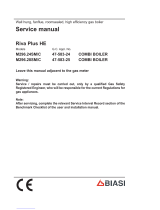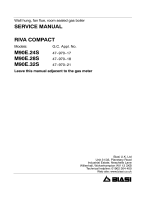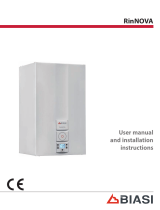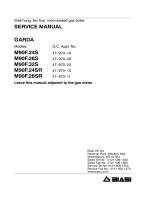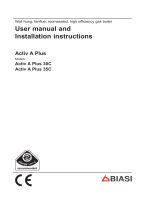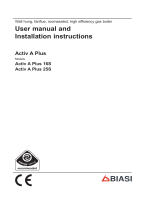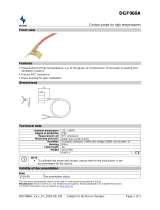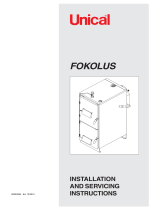
Wall hung, fanflue, roomsealed, high efficiency gas boiler
Service manual
ActivA Plus
Models
Activ A Plus 30C
Activ A Plus 35C
Activ A Plus 16S
Activ A Plus 25S
Leave this manual adjacent to the gas meter
Warning
Service / repairs must be carried out, only by a qualified
Gas Safety Registered Engineer, who will be responsible for
the current Regulations for gas appliances.


- 3 -
TABLE OF CONTENTS
1
OVERALL INFORMATION..........................4
1.1 Overall View .....................................4
1.2 Hydraulic diagram . . . . . . . . . . . . . . . . . . . . . . . . . . . . . . . . . 4
2 GENERAL ACCESS AND EMPTYING HYDRAULIC CIR-
CUITS ..........................................5
2.1 Nomenclature ....................................5
2.2 Case panels......................................5
2.3 Control panel .....................................6
2.4 Main electronic p.c.b. box ...........................6
2.5 Emptying the primary circuit .........................7
2.6 Emptying the d.h.w. circuit...........................7
3 DIAGRAMS .....................................8
3.1 Wiring diagram Activ A Plus 30C - Activ A Plus 35C .......8
3.2 Wiring diagram Activ A Plus 16S - Activ A Plus 25S .......9
3.3 Circuit voltages ..................................10
4 FAULT FINDING.................................11
4.1 Display diagnostic . . . . . . . . . . . . . . . . . . . . . . . . . . . . . . . . 13
5 CONDENSING HEAT EXCHANGER.................14
5.1 Function........................................14
5.2 Removal .......................................14
5.3 Cleaning .......................................15
6 D.H.W. HEAT EXCHANGER .......................16
6.1 Function........................................16
6.2 Removal .......................................16
7 PUMP . . . . . . . . . . . . . . . . . . . . . . . . . . . . . . . . . . . . . . . . .17
7.1 Function........................................17
7.2 Checks.........................................17
7.3 Removal pump ..................................18
7.4 Removal electrical capacitor . . . . . . . . . . . . . . . . . . . . . . . . 18
8 THREE WAY DIVERTER VALVE ....................19
8.1 Function........................................19
8.2 Checks.........................................19
8.3 Removal of the electric actuator .....................19
8.4 Removal of the three way diverter valve ...............20
8.5 Removal of the diverter group .......................20
9 MAIN ELECTRONIC CONTROL/IGNITION P.C.B. ......21
9.1 Function........................................21
9.2 Selection and adjustment devices....................21
9.3 Checking the temperature ..........................22
9.4 Setting the boiler control function modes ..............23
9.5 Checks.........................................26
9.6 Removal of the electronic control p.c.b ................26
9.7 Thermal control in the mode ....................27
9.8 Thermal control in the mode.....................28
10 CONTROL PANEL ELECTRONIC P.C.B. .............29
10.1 Function........................................29
10.2 Normaly information ..............................29
10.3 Info modality ....................................31
10.4 Function modes setting modality.....................31
10.5 Removal of the control panel electronic p.c.b . . . . . . . . . . . 31
10.6 Removal of the interface electronic p.c.b ..............31
11 GAS VALVE ....................................33
11.1 Function........................................33
11.2 Description of the parts - (Figure 11.2) ................33
11.3 Adjustment......................................33
11.4 Checks.........................................35
11.5 Removal of the gas valve ..........................36
12 PRIMARY CIRCUIT FLOW SWITCH .................37
12.1 Function........................................37
12.2 Checks.........................................37
12.3 Removal .......................................37
13 EXPANSION VESSEL AND PRESSURE GAUGE ......38
13.1 Function........................................38
13.2 Checks.........................................38
13.3 Removal of the expansion vessel ....................38
14 D.H.W. FLOW SWITCH, FILTER AND FLOW LIMITER ..39
14.1 Function........................................39
14.2 Description and location of parts - (Figure 14.2) .........39
14.3 Removal of the sensor.............................39
14.4 Checks.........................................39
14.5 Removaloftheowswitchgroupandd.h.w.circuitlter ..40
14.6 Flow limiter .....................................40
15 TEMPERATURE PROBE..........................41
15.1 Function........................................41
15.2 Checks.........................................41
15.3 Removal of the c.h. Temperature probes ..............41
15.4 Removal of the d.h.w. Temperature probes.............42
16 BY-PASS VALVE ................................43
16.1 Function........................................43
16.2 Removal .......................................43
17 FAN AND AIR BOX ..............................44
17.1 Function........................................44
17.2 Removal of the Air box and the Fan ..................44
18 IGNITION, DETECTION ELECTRODES AND BURNER .45
18.1 Function........................................45
18.2 Removal of the Ignition and detection electrodes . . . . . . . . 45
18.3 Removal of the burner.............................45
18.4 Removal of the front insulation panel .................46
18.5 Removal of the rear insulation.......................46
18.6 Checks.........................................46
19 SAFETY THERMOSTAT ..........................48
19.1 Function........................................48
19.2 Checks.........................................48
19.3 Removal .......................................48
20 FLUE TEMPERATURE PROBE NTC AND SAFETY THER-
MAL FUSE .....................................49
20.1 Function........................................49
20.2 Removal .......................................49
20.3 Checks.........................................49
21 CONDENSATE TRAP ............................51
21.1 Function........................................51
21.2 Check the cleanness of the trap .....................51
21.3 Removal .......................................51
22 SHORT SPARE PARTS LIST ......................52

- 4 -
OVERALL INFORMATION
1 OVERALL INFORMATION
1.1 Overall View
Figure 1.1
Pump
Gasvalve
Gas restrictor
Flue temperature
probeNTC
Condensing
heat exchanger
Detection
electrode
Burner
Fan
Electronic controlbox
Three way diverter valve
Ighition
electrodes
Expansion
vessel
Condensate
trap
C.h. pressure
relief valve
D.h.w.heat
exchanger
Automatic air
purger valve
Control
panel
Electric actuator
diverter valve
D.h.w. temperature probe
Airbox
(air/gasmixer)
Main circuit
pressure switch
D.h.w.
flow switch
Pipe silencer
Safety
thermostat
1.2 Hydraulic diagram
Figure 1.2
Centralheating (c.h.) operation
Domestic hotwater (d.h.w.) operation
D.h.w.
inlet
D.h.w.
outlet
C.h.
waterflow
C.h.
water return

- 5 -
GENERAL ACCESS AND EMPTYING HYDRAULIC CIRCUITS
2 GENERAL ACCESS AND EMPTYING
HYDRAULIC CIRCUITS
2.1 Nomenclature
Figure 2.1
1
2
3
4
5
1 Right side panel
2 Front panel
3 Control panel
4 Main electronic p.c.b. box
5 Left side panel
2.2 Case panels
Warning: isolate the boiler from the mains electrici-
ty supply before removing any covering or compo-
nent.
For the most part of the check and maintenance operations it is
necessary to remove one or more panels of the case.
The side panels can be removed only after the removal of the
front panel.
To remove the front panel loosen screws A (Figure 2.2), lift the
panel and remove it.
Figure 2.2
A
B
B
- bottom view of the boiler
Pull the lower part of the front panel and lift it upwards (Figure
2.3).
Figure 2.3
C
C
To remove the side panels loosen the screws B (Figure 2.2) and
C (Figure 2.3).
Pull the side panels towards the outside.
To Fit the case panels
Fit the side case panels.
Warning: Fit the front panel hooking it on the upper
side.
Push the spring towards the internal side of the boiler and simul-
taneously push the front case panel until it is completely hold in
place (Figure 2.4 step 1, 2).
Repeat the same operation on the opposite side of the front pa-
nel (Figure 2.4 step 3, 4).
Ensurethatthefrontpaneledgeisclose-ttingtothesidepanels.
Lock in place the panel with the appropriate screws.
Figure 2.4
1
3
2
4

- 6 -
GENERAL ACCESS AND EMPTYING HYDRAULIC CIRCUITS
2.3 Control panel
Warning: isolate the boiler from the mains electrici-
ty supply before removing any covering or compo-
nent.
To gain access to the parts located inside the control panel pro-
ceed as follows:
1 Remove the front panel of the case
2 Unscrew the screws D and E (Figure 2.5).
3 Free the hooks indicated and rotate the lid towards left.
Figure 2.5
Rotate
Rotate
D
E
4 To access to the parts located behind the control panel turn it
as shown in Figure 2.6.
Figure 2.6
2.4 Main electronic p.c.b. box
Warning: isolate the boiler from the mains electrici-
ty supply before removing any covering or compo-
nent.
To gain access to the parts located intomain electronic p.c.b. box
proceed as follows:
1 Remove the front panel of the case.
Terminal block lid removal
2 To remove the terminal block lid F (Figure 2.7), free the front
hooks.
Figure 2.7
F
3 Slightly rotate the lid as indicated by the curved arrow and
free the rear hooks.
4 Remove the lid.
Main electronic p.c.b. lid removal
To get access to the main electronic p.c.b.:
5 Pull the box that contains the electronic p.c.b. and rotate it
(Figure 2.8).
Figure 2.8

- 7 -
GENERAL ACCESS AND EMPTYING HYDRAULIC CIRCUITS
6 Remove the terminal block lid F (Figure 2.7).
7 Free the hooks placed on the three sides indicated and rotate
the lid towards left (Figure 2.9).
Figure 2.9
2.5 Emptying the primary circuit
1 Closethec.h.circuitowandreturncocksG(Figure2.10).
Figure 2.10
G H
2 Remove the front and right panels of the boiler.
3 Open the drain tap I (Figure 2.11 combi or Figure 2.12 only
c.h.) until the boiler is completely emptied.
4 To help the draining of the primary circuit loose the condens-
ing heat exchanger air purger valve.
Figure 2.11
OPEN
CLOSED
I
Figure 2.12
I
2.6 Emptying the d.h.w. circuit
1 Close the d.c.w. inlet cock H (Figure 2.10).
2 Open one or more hot water taps until the boiler has been
completely emptied.

- 8 -
DIAGRAMS
3 DIAGRAMS
3.1 Wiring diagram Activ A Plus 30C - Activ A Plus 35C
Figure 3.1
bk
bu
bn
bn
bu
bk
1
2
3
L
N
M
~
1
2
3
1
3
4
t
t
M
~
t
t
t
Safety
OUT
GND
5V
OUT
GND
5V
bn =brown
bu =blue
bk =black
wh =white
rd =red
gy =grey
gn =green
ye =yellow
vt =violet
og =orange
gnye =green/yellow
rdwh =red/white
gnye
bn
rd
bk
bu
rd
br
bk
bu
gnye
bu
bn
bu
bu
bn
gy
bk
bu
rd rd
bu
bk
bu
bn
gnye
whwh
gy
wh
wh
wh
bu
bn
bu
bn
br
bu
og
og
gnye
bu
bn
bu
bn
gnye
ye
bk
ye
wh
wh
bk
bk
rd
rd
bk
bk
bk
wh
wh
wh
wh
wh
t
wh
bk
bk
bk
bk
rd
bu
bu
bu
bu
bk
bk
wh
wh
rd
rd
rd
wh
wh
rd
rd
bu
bu
rd
rd
rd
rd
wh
wh
wh
wh
wh
bk
bk
bk
bk
diverter valve
Threeway
Pump
Gasvalve Fan
Ignition
electrodes
Flamedetection
electrode
Flue temp.
probeNTC
C.h. temperature
probeNTC
thermalfuse
return
C.h. temperature
probeNTC
flow
D.h.w. outlet
probeNTC
temperature
D.h.w. inlet
probeNTC
temperature
D.h.w. flow
switch
pressure switch
Primarycircuit
Safety
thermostat

- 9 -
DIAGRAMS
3.2 Wiring diagram Activ A Plus 16S - Activ A Plus 25S
Figure 3.2
bk
bu
bn
bn
bu
bk
1
2
3
L
N
M
~
1
2
3
1
3
4
t
M
~
t
t
t
OUT
GND
5V
bn =brown
bu =blue
bk =black
wh =white
rd =red
gy =grey
gn =green
ye =yellow
vt =violet
og =orange
gnye =green/yellow
rdwh =red/white
gnye
bn
rd
bk
bu
rd
br
bk
bu
gnye
bu
bn
bu
bu
bn
gy
bk
bu
rd rd
bu
bk
bu
bn
gnye
whwh
gy
wh
wh
wh
bu
bn
bu
bn
br
bu
og
og
gnye
bu
bn
bu
bn
gnye
ye
bk
ye
wh
wh
bk
bk
rd
rd
bk
bk
bk
wh
wh
bk
bk
bk
bk
rd
bu
bu
bu
bu
bk
bk
wh
wh
rd
rd
rd
wh
wh
wh
wh
wh
bk
bk
bk
bk
diverter valve
Threeway
Pump
Gasvalve Fan
Ignition
electrodes
Flamedetection
electrode
Flue temp.
probeNTC
C.h. temperature
probeNTC
thermalfuse
return
C.h. temperature
probeNTC
flow
pressure switch
Primarycircuit
Safety
thermostat

- 10 -
DIAGRAMS
3.3 Circuit voltages
Figure 3.3
230~
Electrical voltages with burner on
during c.h. or d.h.w. operation
only during c.h. operation
only during d.h.w. operation
230~
Safety
thermostat
1
Fan
0
Main circuitSupply network
230~ 0230~0
3way
diverter valve
230~
Gasvalve
33...200Hz
0...32 Hz
D.h.w.
Flow switch
pressure switch

- 11 -
FAULT FINDING
Components to check
Sectionofthe manual →
(noteref.inbrackets)
---
(1)
---
(2)
---
(3)
21.1 ---
(4)
5
6
7.2
8.2
14.3
9.5
10 11.4 12.2
14.5 15.2
16
17
18.4
19.2 19.2
20.1
---
(7)
---
---
---
Appliancelock--- out(*)
Defect
↓
Powersupplyline
Gassupplyline
Flue pipes
Cond.drain pipe andtrap
C.h. circuit
D.h.w. circuit
Condensing heat exchanger
D.h.w. heat exchanger
Pump
Diverter valve
D.h.w. flow switch
Fuses(Electronic p.c.b.)
Mainelectronicp.c.b.
Boiler settings
Controlpanel electr.p.c.b.
Gasvalve
Maincircuit pressure switch
D.h.w. filter
Maincircuit temp.probe
D.h.w. temp.probe
By---passvalve
Fan/airrestrictor
Ignition electrode
Detectionelectrode
Safety thermostat
Gasrestrictor
Flue temp.probe NTC
Expansionvessel
Safety valve
Pressure gauge
External temp.probe
E01
E02
E03
E04
E05
E06
E07
E08
s”E”
E09
c
ate
s
E10
indi
c
E11
E12
E13
p
layi
E14
E20
Disp
4 FAULT FINDING

- 12 -
FAULT FINDING
Components to check
Sectionofthe manual →
(noteref.inbrackets)
--------
--
--
(7)
2.912.911.0218.4617115.24.112.215.41109.514.32.72.865---
(4)
21.1---
(3)
---
(2)
---
(1)
Appliancelock--- out(*)
External temp.probe
Pressure gauge
Safety valve
Expansionvessel
Flue temp.probe NTC
Gasrestrictor
Safety thermostat
Detectionelectrode
Ignitionelectrode
Fan/airrestrictor
By---passvalve
D.h.w. temp.probe
Main circuittemp. probe
D.h.w. filter
Main circuitpressure switch
Gasvalve
Controlpanel electr.p.c.b.
Boiler settings
Main electronic p.c.b.
Fuses(Electronic p.c.b.)
D.h.w. flow switch
Diverter valve
Pump
D.h.w. heat exchanger
Condensing heat exchanger
D.h.w. circuit
C.h. circuit
Cond.drain pipe andtrap
Flue pipes
Gassupplyline
Powersupplyline
Defect
↓
Theboiler does notstart either in
c/hord.h.w.mod e.
Thecontrol paneldisplay OFF
Fanstill.
Theboiler does notsupplyd.h.w.
(cold waterfromthe tap).
Regularoperation in c/hmodeeven
during adrawing offd.h.w.
d
isplay
On c/hmodethe temperatureof
themaincircuit reaches90Cand
thec/h system does notheat.
Theboileroperates correctly on
d.h.w. mode.
on di
Incorrectmodulation
t
ion
o
Noisybolier
d
icati
Poor c.h. /d.h.w.temperature
(9)
”Er” ind
Poor d.h.w. temperature. Regular
operationinc/h mode.
(8)
No ”
Lowd.h.w.flowrate
---
Waterleaks from thesafetyvalve
during operationonc/h
---
Waterleaks from thesafetyvalve
when theboilerisoff.
*Lockout is indicatedas“E ”onthe display.
Note
Useful informatio ncan be obtained also from the
opticalindicationgiven by theappliance display
(see section4.1).
1Check for230V~between line (L)and neutral(N)
Ve rify theintegrity of su pply cable, plug andexternalfuses.
Checkthe polarity of line and neutralconnection
2Check thegas supply pipe andisolation tapfor gastightness.
3Check forsoundness and absenceofobstructions. Verify that
theflueterminal is correctly installed(seeclearances) anden-
sure that exhaustgas is notsuckedbackbythe boiler.
4Check forsoundness of thecircuit andverif yits correct filling
(see also installation manual).
5Ajammed by---passcould causethe over --- heatingofthe main
circuitand theinterventionofthe safety thermostat.
6Using theflu eanalyzer, checkthe CO
2
value of theflue gases.
This readingisareferencevalue forthe gasvalve setting.
7Check thepressurization of theexpansion vessel.Refer to the
installation manual forpropervalues.
8d.h.w.pressure toohighorflowratetoo high.Ifnecessary in-
sert aflowratelimiter (14.6).
9The boiler doesn’treach thenominal heat input.

- 13 -
FAULT FINDING
4.1 Display diagnostic
Thedisplayindicationsprovidehelpinthediagnosisoffaultn-
ding.
The control panel display gives other information for the user.
The following table gives fault code, error and the reson for the
fault.
E01 + RESET Lack of burner ignition on safety lockout
E02 + RESET Safety thermostat intervention lockout
E03 + RESET Generallockout
E04 +
Little pressure in the system or pressure
transducer disconnected
E05 +
Pressure switch anomaly (if present)
E06 +
Faulty c.h. temp. probe NTC1 or NTC2
E07 +
Faulty d.h.w. temp. probe NTC
E08 +
Faulty external temp. probe NTC (with K
set)
E09 +
Faultyuetemp.probeNTC(ifpresent)
E10 + RESET Flue probe intervention lockout (if present)
E11 + RESET Flame detection error
E12 +
Failure return NTC probe
E13 +
∆Tdelivery-return>40K(ifforeseen)
E14 + RESET Faulty pump or primary temperature above
105°C
E14 +
Absenceofowfromtemperaturegradient
(>2K/s)
E20 + RESET LockoutEVG
E21 + RESET LockoutEVG
E22 + RESET LockoutEVG
E23 + RESET LockoutEVG
E24 + RESET Abnormal combustion ignition lock
E25 + RESET Abnormal combustion operation lock
E69 +
Wiring error lockout
E99 +
Boilernotcongured
L01 Primary circuit temp. limit during D.h.w.
operation

- 14 -
CONDENSING HEAT EXCHANGER
5 CONDENSING HEAT EXCHANGER
5.1 Function
The Condensing heat exchanger A in (Figure 5.1) has the fun-
ction of transferring heat produced from combustion of the gas
andfromtheueexhaustedgastothewatercirculatinginit.
Figure 5.1
A
B
C
By reducing the combustion products temperature, the latent
heat of the vapour is transferred to the water circuit, allowing an
extra gain of useful heat.
The condensed vapour is then drained through the condensate
trap B and the draining pipe C.
5.2 Removal
Warning: isolate the boiler from the mains electricity
supply before removing any covering or component.
1 Disconnecttheuesystemfromtheboiler.
2 Remove the fan group (rubber pipe, gas pipe) following the
instructions from 1 to 6 in section "Removal of the Air box and
the Fan" page 44.
3 Disconnect the detection electrode connector D, the ignition
electrodes connector E and the earth wire F.
4 Disconnect the fan connector G by pressing the plastic hook
placed on the side of the connector (Figure 5.2).
5 Unscrew the nuts H (Figure 5.2).
6 Remove the fan-burner group I.
7 Empty the primary circuit of the boiler.
8 Remove the clips J (Figure 5.2).
9 Loosen the connection K and slightly move the pipe L up-
wards, turn it towards left (Figure 5.2) and then move the pipe
downwards freeing it from the Condensing heat exchanger.
Figure 5.2
D
E
F
G
H
I
J
K
L
M
N
10 Loosen the connection M and slightly move the pipe N up-
wards, turn it towards left (Figure 5.2) and then move the pipe
downwards freeing it from the Condensing heat exchanger.
Figure 5.3
O
P
Q
R
11 Using pliers, remove the spring O moving it downwards and
disconnect the rubber pipe P (Figure 5.3).

- 15 -
CONDENSING HEAT EXCHANGER
12 Unscrew the screws Q and remove the clamps (Figure 5.3).
13 Disconnect the two connectors R by pressing the plastic hook
placed on the side of the connector (Figure 5.3).
14 Remove the Condensing heat exchanger by levering it and
sliding it forwards.
15 Reassemble the Condensing heat exchanger carrying out
the removal operations in reverse order.
Ensure to tighten the nuts H - Figure 5.2 rmly.
5.3 Cleaning
If there are deposits of dirt on the coil of the Condensing heat
exchanger, clean with a bristle paintbrush and remove the dust
with a hoover.
Warning: After cleaning or replacement as detailed
above, if it deemed necessary to undertake a com-
bustion analysis as detailed in chapter 11.3 section
11.
Figure 5.4
S
Caution:
After any periodical servicing or disturbance the combustion
chamber silicon seal S Figure 5.4 must be fully inspected and
replaced at the discretion of the service engineer.
After any disturbance to the chamber door seal the appliance
must undergo a full analytical combustion performance check.

- 16 -
D.H.W. HEAT EXCHANGER
6 D.H.W. HEAT EXCHANGER
6.1 Function
The d.h.w heat exchanger A in Figure 6.1 and Figure 6.3 allows
the instantaneous transfer of heat from the primary hydraulic cir-
cuit to the water destined for d.h.w use.
Figure 6.1
A
The schematic structure is shown in Figure 6.2.
Figure 6.2
Primaryhydraulic circuit
Domestic hotwater circuit
6.2 Removal
Warning: isolate the boiler from the mains electrici-
ty supply before removing any covering or compo-
nent.
1 Remove the panels of the case.
2 Empty the primary circuit and the d.h.w circuit of the boiler.
3 Remove the control panel following the instructions from 4 in
section 2.3.
4 Remove main electronic p.c.b. box following the instructions
from 5 in section 2.4.
5 Remove the pump following the instructions in section 7.3.
6 Completely unscrew the Allen key screws B in Figure 6.3
which hold the exchanger to the plastic groups.
Figure 6.3
B
A
B
7 Move the exchanger towards the rear of the boiler and extract
it to the left.
Reassemble the d.h.w. heat exchanger carrying out the removal
operations in the reverse order.
W
arning: to lubricate the O-ring gaskets exclusive-
ly use a silicone base grease compatible to be in
contact with foods and approved by the local water
Authorities.
Warning: When reassembling the exchanger be sure
to put the off center location/securing pin indicated
in Figure 6.4 towards the left side of the boiler.
Figure 6.4

- 17 -
PUMP
7 PUMP
7.1 Function
The pump A in Figure 7.1 and Figure 7.3 has the function of ma-
king the water in the main circuit circulate through the main con-
densing heat exchanger and therefore through the c.h. system
(during the c.h. function) or through the secondary heat exchan-
ger (during the d.h.w. function).
Figure 7.1
A
7.2 Checks
Warning: isolate the boiler from the mains electricity
supply before removing any covering or component.
Check that the pump is not seized and that the movement of
the rotor is not subject to mechanical impediments.
With the boiler off, remove the front panel. Remove the air relea-
se plug of the pump and turn the rotor with a screwdriver.
Check the electrical continuity.
With the boiler off, remove the front panel and disconnect the
connector B (Figure 7.3).
Measure the electrical resistance between the pump supply con-
nections.
Figure 7.2
1
2
3
5
4
6
Electrical resistance of the windings (at ambient temperature)
must be:
COIL RESISTANCE
1 - 4 110Ω
1 - 6 215Ω
2 - 3 0Ω
2 - 5 230Ω
3 - 5 230Ω
4 - 6 110Ω
Check the absence of starting defects.
With the boiler off remove the front case panel.
Remove the air release plug from the pump. Start the boiler and
with a screwdriver, turn the rotor in the direction of the arrow.
If there is a defect in starting, the rotor will begin to turn normally
only starting it manually.
Check that the impeller is integral with the rotor.
With the boiler off remove the front and right hand side case pa-
nels, lower the control panel and empty the primary circuit.
Remove the pump head by undoing the screws which hold it to the
pumpbodyandcheckthattheimpellerisrmlyjoinedtotherotor

- 18 -
PUMP
7.3 Removal pump
Warning: isolate the boiler from the mains electricity
supply before removing any covering or component.
1 Remove the front and right hand side case panels.
2 Empty the primary circuit of the boiler.
3 Disconnect the connector B (Figure 7.3) following the indica-
tions given on the connector box.
4 Disconnect the earth connector C.
Figure 7.3
B
A
C
D
E
F
G
H
I
J
5 LoosentheconnectionG,andpullupandturntotheleftthe
pipe H.
6 Remove the fork F, loosen the connection J and remove the
pipe I.
7 Remove the locking plate D.
8 Unscrew the two screws E that hold the pump on the frame
and remove the pump.
Reassemble the pump carrying out the removal operations in the
reverse order. When reassembling the pump, check the correct
location of the O-ring gasket in the inlet port of the pump that
seals the connection between the pump and the plastic group.
7.4 Removal electrical capacitor
Warning: isolate the boiler from the mains electricity
supply before removing any covering or component.
1 Remove the front and right hand side case panels.
2 Disconnect the connector B (Figure 7.3) following the indica-
tions given on the connector box.
3 Remove the connector K of the cover box by levering with a
screwdriver in as shown in (Figure 7.4)
Figure 7.4
K
4 Remove the capacitor connection block L freeing it from the
hook M and pulling it as indicated by the arrow (Figure 7.5).
Figure 7.5
L M

- 19 -
THREE WAY DIVERTER VALVE
8 THREE WAY DIVERTER VALVE
8.1 Function
The diverter valve A (Figure 8.1) has the function of modifying the
hydraulic circuit of the boiler by means of an electric command
given by the electronic control p.c.b. in order to send the water
that exits the primary heat exchanger towards the c.h. system or
towards the d.h.w. heat exchanger.
Figure 8.1
A
8.2 Checks
Warning: check the electrical continuity.
Figure 8.2 indicates the relationship between the electric com-
mand coming from the electronic control p.c.b. and the position
of the actuator B (brass spindle) when the boiler operates in
d.h.w. mode.
Figure 8.3 indicates the relationship between the electric com-
mand coming from the electronic control p.c.b. and the position
of the actuator B (brass spindle) when the boiler operates in c.h.
mode.
Inbothgurestherelationshipbetweenthepositionoftheactua-
tor and the resistance of the motor windings (the motor must be
disconnected from the wiring) is also given.
Figure 8.2
bk =black
Open circuit
9,4Kohm
3
bnbubk
21
bu =blue
bn =brown
230 V
0 V
B
Spindle visible
D.h.w. mode
Figure 8.3
bk =black
Open circuit
9,4Kohm
3
bnbubk
21
bu =blue
bn =brown
0 V
230 V
B
Spindle not visible
C.h. mode
8.3 Removal of the electric actuator
Warning: isolate the boiler from the mains electrici-
ty supply before removing any covering or compo-
nent.
1 Remove the front case panel.
2 Disconnect the connectors C (Figure 8.4).
3 RemovethexingspringDandremovetheactuatorE.
Reassemble the actuator carrying out the removal operations
in the reverse order.
When reassembling the actuator, refer to Figure 8.3 or to the
wiring diagram in section 3 for the correct wiring connection.

- 20 -
THREE WAY DIVERTER VALVE
Figure 8.4
C
D
E
8.4 Removal of the three way diverter valve
1 Remove the front and both side case panels.
2 Empty the primary circuit and the d.h.w circuit of the boiler.
3 Remove the electric actuator (see "Removal of the electric
actuator" page 19).
4 RemovethexingspringF(Figure8.5)
5 Remove the threewaydiverter valve G by levering with a
screwdriver in as shown in Figure 8.5.
Figure 8.5
F
G
H
Reassemble the three way diverter valve carrying out the remo-
val operations in the reverse order.
W
arning: to lubricate the O-ring gaskets exclusively
use a silicone base grease compatible to be in con-
tact with foods and approved by the local water Au-
thorities.
Attention. When reassembling the three way diverter valve
be sure that the three way diverter is correctly oriented by
matching the reference H with the notch of the water group
Figure 8.5.
8.5 Removal of the diverter group
1 Remove the front and both side case panels.
2 Empty the primary circuit and the d.h.w circuit of the boiler.
3 Remove the electric actuator (section "Removal of the elec-
tric actuator" page 19).
4 RemovethexingspringI(Figure8.6)andremovethepri-
marycircuitowswitchJ.
Figure 8.6
I
J
5 Disconnect d.h.w. temperature probe K.
Figure 8.7
K
L
M
6 UnscrewtheconnectorL(Figure8.7),thec.h.owconnector
and the d.h.w. outlet connector.
7 Remove the d.h.w. heat exchanger (see "Removal" page
16).
8 Unscrew the screw M and remove the diverter group.
9 Reassemble the diverter group carrying out the removal op-
erations in the reverse order.
W
arning: to lubricate the O-ring gaskets exclusively
use a silicone base grease compatible to be in con-
tact with foods and approved by the local water Au-
thorities.
Page is loading ...
Page is loading ...
Page is loading ...
Page is loading ...
Page is loading ...
Page is loading ...
Page is loading ...
Page is loading ...
Page is loading ...
Page is loading ...
Page is loading ...
Page is loading ...
Page is loading ...
Page is loading ...
Page is loading ...
Page is loading ...
Page is loading ...
Page is loading ...
Page is loading ...
Page is loading ...
Page is loading ...
Page is loading ...
Page is loading ...
Page is loading ...
Page is loading ...
Page is loading ...
Page is loading ...
Page is loading ...
Page is loading ...
Page is loading ...
Page is loading ...
Page is loading ...
Page is loading ...
Page is loading ...
Page is loading ...
Page is loading ...
/

